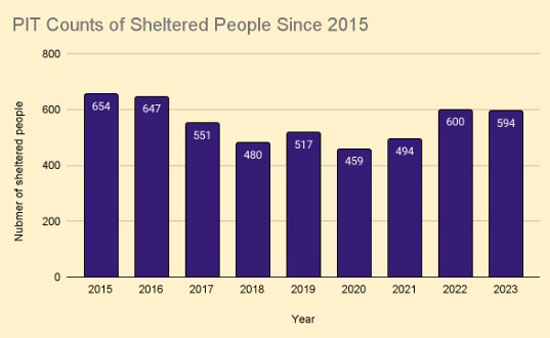SNOHOMISH COUNTY — Every year, a group of volunteers conducts a count of people experiencing homelessness in all United States counties in the month of January. This year, Snohomish County’s number was the highest it’s been in more than a decade.
The Point In Time count is an important approximation of where the county stands with homelessness. Nearly 1,300 people were without housing in Snohomish County during the snapshot survey held a specific day in January.
The survey counts have been increasing every year since 2018, according to Deputy Communications Director of Snohomish County Kelsey Nyland.
Point In Time counts can be imperfect because they are merely a snapshot of one day’s worth of counting, but they show trends, according to Stephanie Patterson, the supervisor for the Homeless Management Information System team of Snohomish County. For example, volunteers weren’t allowed to count sheltered people in 2021 due to COVID-19, Patterson said.
“We can’t literally count every single person that might be homeless,” said Patterson. “This count just helps the county identify trends and needs for services.”
PIT Count results year-by-year
 Bar graph of PIT counts since 2015. The graph shows a steady increase in numbers of people experiencing homelessness since a drop into triple digits in 2018. 2021’s count was hindered by COVID-19 precautions. Data courtesy of the Snohomish County Homeless Management Information System.
Bar graph of PIT counts since 2015. The graph shows a steady increase in numbers of people experiencing homelessness since a drop into triple digits in 2018. 2021’s count was hindered by COVID-19 precautions. Data courtesy of the Snohomish County Homeless Management Information System.
 Bar graph of sheltered counts of PIT totals since 2015. The Homeless Management Information System team of Snohomish County Human Services divides the PIT count to note how many individuals are in emergency shelters. Data courtesy of the Snohomish County Homeless Management Information System.
Bar graph of sheltered counts of PIT totals since 2015. The Homeless Management Information System team of Snohomish County Human Services divides the PIT count to note how many individuals are in emergency shelters. Data courtesy of the Snohomish County Homeless Management Information System.
The United States Department of Housing and Urban Development uses the PIT count to consider how effective a community’s housing services are and whether or not federal intervention is necessary.
Similarly to years before, the majority of the people included in the count were spending the night in Everett and other larger city areas. However, this year the count is up in every separate part of the county with all locations seeing similar percentage increases according to Patterson.
From the viewpoint of Snohomish County, this continuation of the increase in populations of homeless people since 2018 means they must yet again increase public housing to meet their needs.
“Our residents experiencing homelessness need stable housing and supportive services, which is why we are taking a holistic approach to increase affordable housing, shelter, and behavioral health services across Snohomish County,” Snohomish County Executive Dave Somers said.
Homeless populations decreased 19.5 percent from 1,066 to 858 in 2018’s PIT count, but Nyland cited rental vacancies allowing for the rapid rehousing of individuals.
“Market conditions have changed dramatically since then; there are virtually no low-rent vacancies available,” Nyland said.
On the night of the count, Jan. 24, the weather was unseasonably warm.
“One variable that affected our PIT count was the weather,” said Patterson. “The cold weather shelters were closed that night so our sheltered count was lower than expected with the increase in total count that we saw.”
Temporary shelter needs are an important public service that Snohomish County provides based on necessity shown by Patterson’s data management team. Because of the increases in homeless people shown by 2022 and 2023’s PIT counts, the county used part of their American Rescue Plan Act allocation to purchase two motels in Everett and transform them into emergency shelters with wraparound services for people experiencing homelessness. Nyland acknowledged the New Start Centers as vital in providing for Snohomish County’s emergency shelter needs.
However, Nyland said the county’s standpoint is that increasing affordable permanent housing is the only way to have a real impact on the homelessness crisis.
In December 2021, Somers proposed, and the County Council approved, implementing a state-sanctioned 0.1% county sales tax, the vast majority of which will fund affordable housing.
According to Nyland, Snohomish County’s calculations have shown that this new funding could provide additional units of affordable housing. But that is dependent on income from the sales tax.
Ultimately, the PIT is meant to help the federal government decide which counties need assistance in their human services.
“We need the State and federal governments to significantly increase investments in affordable housing to meaningfully address this crisis,” said Nyland.
 Bar graph of PIT counts since 2015. The graph shows a steady increase in numbers of people experiencing homelessness since a drop into triple digits in 2018. 2021’s count was hindered by COVID-19 precautions. Data courtesy of the Snohomish County Homeless Management Information System.
Bar graph of PIT counts since 2015. The graph shows a steady increase in numbers of people experiencing homelessness since a drop into triple digits in 2018. 2021’s count was hindered by COVID-19 precautions. Data courtesy of the Snohomish County Homeless Management Information System. Bar graph of sheltered counts of PIT totals since 2015. The Homeless Management Information System team of Snohomish County Human Services divides the PIT count to note how many individuals are in emergency shelters. Data courtesy of the Snohomish County Homeless Management Information System.
Bar graph of sheltered counts of PIT totals since 2015. The Homeless Management Information System team of Snohomish County Human Services divides the PIT count to note how many individuals are in emergency shelters. Data courtesy of the Snohomish County Homeless Management Information System.